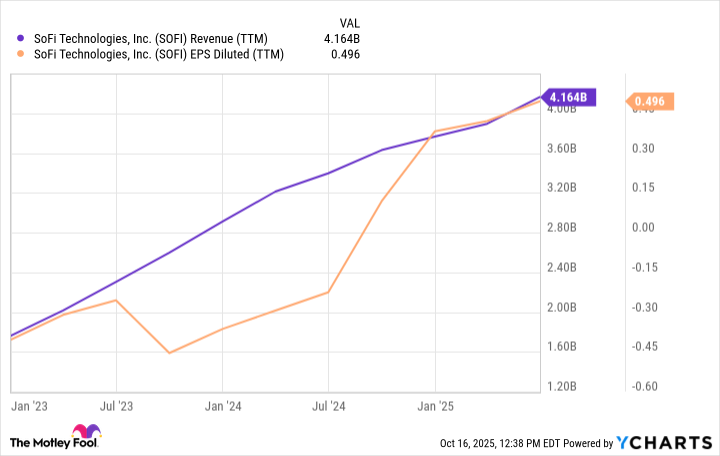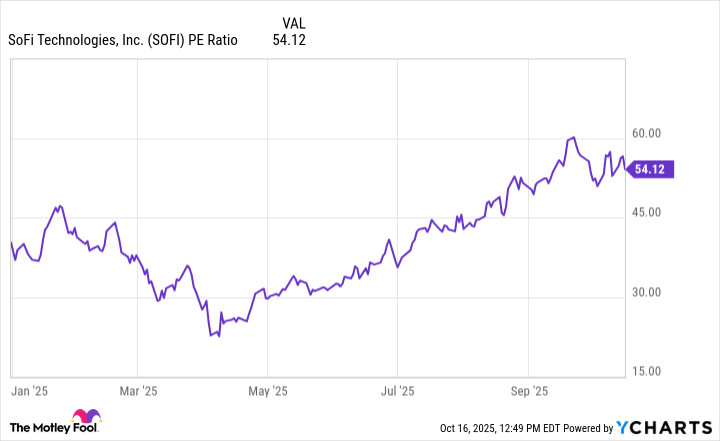SoFi Technologies (SOFI 6.15%) has quickly become one of the most talked-about names in fintech, and for good reason. What initially began as a niche platform for student loan refinancing has transformed into a comprehensive digital financial ecosystem. Today, SoFi offers everything from checking and savings accounts to mortgages, investment services, and credit cards -- all within a single app.
Investors are taking notice because SoFi is redefining what it means to be a modern financial institution. By seamlessly blending technology with finance, the company has captured the attention of younger demographics -- particularly millennials and Gen Z -- who prefer managing their money through their smartphones rather than visiting physical bank branches.

NASDAQ: SOFI
Key Data Points
A modern alternative to traditional banks
What sets SoFi apart from traditional financial institutions is its digital-first, vertically integrated business model. Unlike legacy banks weighed down by costly brick-and-mortar networks and outdated software infrastructure, SoFi operates entirely online. This lets it offer lower fees, higher yields, and faster loan approvals.
The company's greatest advantage lies in its convenience and ecosystem approach. Members can borrow, spend, invest, and manage their finances all within a single app. This seamless integration transforms SoFi from a traditional bank into an end-to-end lifestyle platform -- one designed around accessibility and financial empowerment.
The SoFi flywheel: Growth through cross-selling and innovation
SoFi's growth strategy is built around a powerful flywheel effect. The company attracts new users with competitive rates on checking, savings, and personal loans. Then, it cross-sells complementary products like investing, insurance, and credit cards. Recent results show that this approach is working. By the end of the second quarter, SoFi had 11.7 million customers using a combined 17.1 million products, meaning the average user engages with more than one offering.
SOFI Revenue (TTM) data by YCharts.
This multi-product engagement creates strong, recurring relationships that reduce churn and boost customer lifetime value -- a dynamic that supports both accelerating revenue and consistent earnings growth. Moreover, this expanding base of high-quality customers gives SoFi the confidence and flexibility to expand into new product categories.
For example, SoFi recently relaunched cryptocurrency trading, as well as its own line of exchange-traded funds (ETFs). This broadens its appeal to investors seeking more than just basic banking tools.
By reinvesting profits into innovation, SoFi ensures it stays ahead of the curve, deepening customer loyalty and reinforcing its position as one of the most dynamic names in fintech.
Valuation, competition, and the road ahead
Of course, SoFi is not operating in a vacuum. The company faces stiff competition from other modern innovators such as Robinhood Markets, Chime, Block (formerly Square), PayPal, and even Coinbase -- all of which are vying for consumer attention in digital banking and investing. Despite these rivals, SoFi continues to stand out thanks to its diversified ecosystem and focus on member growth.
To be sure, the stock's valuation already reflects lofty expectations. With a price-to-earnings (P/E) ratio of roughly 54, SoFi trades more like a high-growth technology company than a traditional financial institution.
SOFI PE Ratio data by YCharts.
Much of the optimism stems from the possibility that Federal Reserve rate cuts could reignite growth in SoFi's core lending business, unlocking pent-up demand for mortgages, small business loans, and personal financing.
Although I view SoFi primarily as a tech-enabled financial service, it's hard to ignore the stock's recent valuation expansion. Still, for investors who believe in the long-term shift toward integrated, app-based finance, SoFi offers a compelling growth story -- one that bridges the gap between Silicon Valley innovation and Wall Street discipline.







